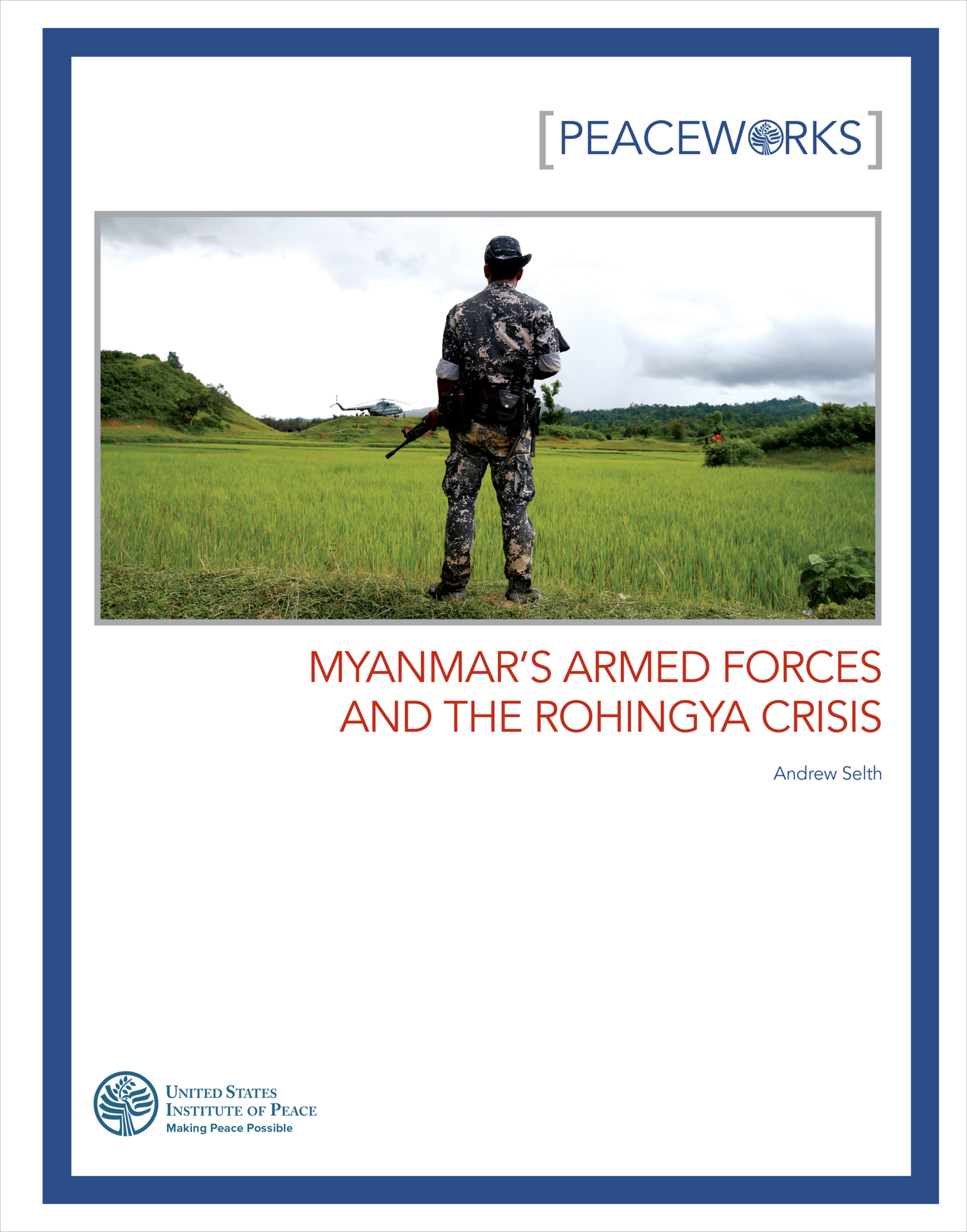In 2016 and 2017, in response to small attacks by the Arakan Rohingya Salvation Army, Myanmar’s armed forces launched “area clearance operations” against the Rohingya minority in Rakhine State—a response the U.S. government has called ethnic cleansing. This report explores the structure, training, and ethos of Myanmar’s armed forces to clarify the implications and challenges of, and the prospects for, finding constructive ways forward as well as an accounting for the past. Drawing on an in-depth review of the literature, extensive field experience, and interviews, the report is published by the United States Institute of Peace as part of its effort to inform policy and strategies on managing violent conflict. The views expressed in this report are those of the author, and do not necessarily reflect the views of USIP.
Summary
- It has long been argued that Myanmar’s armed forces, or Tatmadaw, should be held legally accountable for a wide range of offenses against the Myanmar population.
- These concerns were highlighted in 2016 and 2017, after the armed forces and national police launched “area clearance operations” against the Muslim Rohingya minority in Rakhine State. More than seven hundred thousand refugees were driven into Bangladesh, prompting renewed calls for Myanmar to be brought before an international court, charged with crimes against humanity, including ethnic cleansing and genocide.
- The security forces claim that they were responding to threats to Myanmar’s unity, stability, and sovereignty from Islamist terrorists. Accordingly, they implemented a comprehensive strategy to deprive the militants of food, funds, intelligence, and recruits. Many observers, however, believe the Tatmadaw’s long-term aim is to expel all Rohingyas from Rakhine State.
- Should this matter ever come before an international court, many issues would need to be considered. Most relate directly to the atrocities perpetrated against the Rohingyas. However, the tribunal would also need to consider the Tatmadaw’s organization and structure, its training and ethos, and—most important—command and control issues.
- The Tatmadaw is an effective military organization with a hierarchical structure. In asking the question of who is responsible for the behavior of troops in the field, the easy answer is the commander-in-chief of defense services. In practice, however, the exercise of military power in Myanmar is more complicated.
- There are in effect two Tatmadaws. One operates according to formal structures and regulations, and emphasizes patriotism, professionalism, and personal integrity. The other operates from day to day according to a more informal set of rules that allows for considerable flexibility, including in the observance of humanitarian law.
- Many observers believe that human rights abuses in Myanmar are official policy. They argue that troops are ordered to commit them as deliberate acts of psychological warfare, to undermine the morale of opposing forces, intimidate noncombatants, or force them to leave contested areas. They claim that atrocities like rape are used as weapons of war.
- Uncovering abuses in Myanmar is not difficult, but obtaining hard evidence of troops being ordered to commit them is. This is not surprising, but it argues for caution in claiming that state terror is routinely used to achieve strategic goals. Even if specific orders are not given, however, the Tatmadaw’s failure to punish those guilty of such crimes must encourage them.
- The latest campaign against the Rohingyas has been a disaster for everyone. The Rohingyas have suffered most, but Aung San Suu Kyi, her government, the security forces, and the people of Myanmar have all lost, in different ways. Despite the high hopes that followed the 2015 elections, the country has stepped back into its dark past. This poses real challenges for the international community.
- All Myanmar governments have resisted external pressures to adopt or adapt particular policies. This is unlikely to change. Indeed, with regard to the Rohingyas, a rare consensus between the government, armed forces, and civil population can only strengthen Naypyidaw’s determination to decide its own agenda and timetable for any changes.
- Unless attitudes in Myanmar shift significantly, a fair and durable solution to the Rohingya crisis, let alone a full legal accounting for past events, will remain a distant prospect.
About the Report
In the wake of the 2016 and 2017 “area clearance operations” against the Rohingya minority in Myanmar’s Rakhine State, this report explores the structure, training, and ethos of the Myanmar armed forces to clarify the implications and challenges of, as well as the prospects for, a solution and an accounting for past events. Drawing on an in-depth review of the literature, extensive field experience, and interviews, the report is produced by the Asia Center at the United States Institute of Peace (USIP) as part of its effort to inform policy and strategies on managing violent conflict.
About the Author
An adjunct associate professor at the Griffith Asia Institute, Griffith University, in Brisbane, Australia, Andrew Selth has studied international security issues and Asian affairs for forty-five years as a diplomat, strategic intelligence analyst, and research scholar. He has published seven books and more than fifty peer-reviewed works, most of them about Myanmar and related subjects. He has also contributed to the public debate with numerous articles and reports and in online forums.
